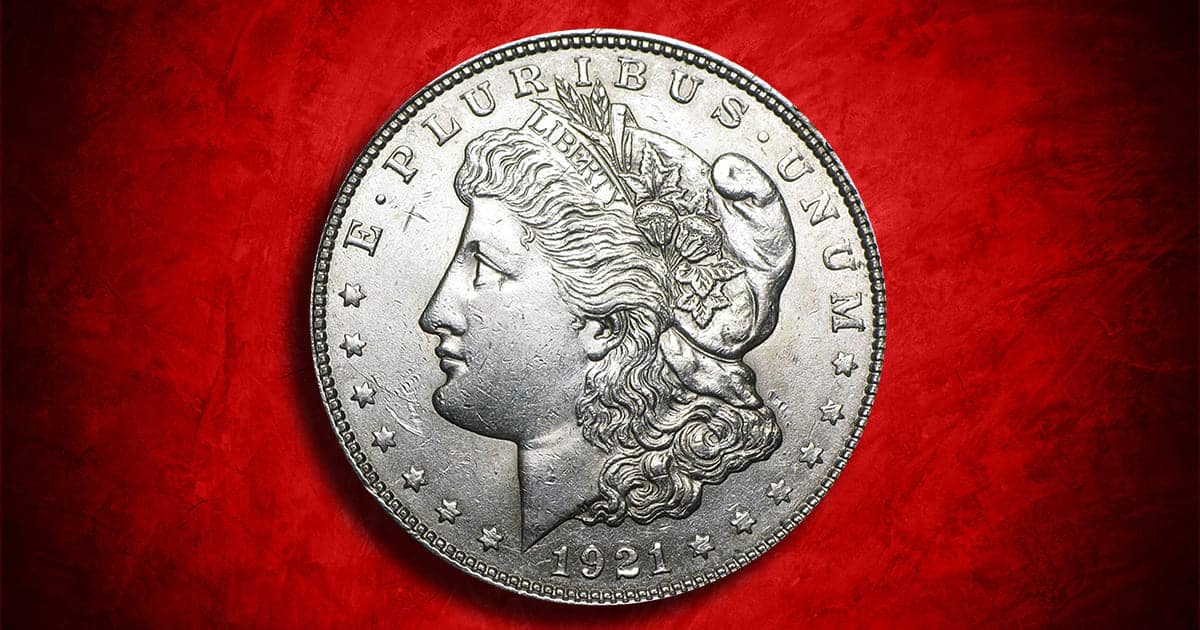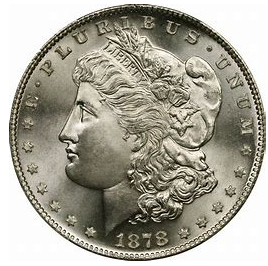
Before the Morgan Silver Dollar’s inception in 1878, many key events had to happen first in America’s mines, economy, and government a few years earlier.
The Comstock Lode
In 1859, silver was found underground in Nevada. It was the first significant discovery of silver in U.S. history. The “Comstock Lode” is a lode of silver ore located near Virginia City, Nevada. The Comstock Lode was under the eastern slope of Mount Davidson, a peak in the Virginia Range. It was the first significant discovery of silver ore in the United States and was named after American miner Henry Comstock. The vein of silver was so vast that the U.S. Government, after much persuasion by mining interests, agreed to build a mint in Carson City, Nevada. This mint was constructed to make it easy for the miners to turn their silver ore into coins instead of shipping it to Philadelphia or San Francisco, which was very busy striking gold coins from the gold found at Sutter’s Mill.

The amount of silver that was mined was extraordinary. Some miners missed the U.S. Civil War due to their interest in Comstock Lode. However, during the 1860-1865 period, many mining companies fought over claims to parts of the Comstock Lode. By 1869, Ohio Senator John Sherman had introduced a revised law to end bimetallism. The supporters of gold saw that the low price of silver, due to the development of the Comstock Lode and other affluent silver-mining areas, would cause large quantities of silver dollars to be struck and the gold standard to be endangered. The legislation, called “The Coinage Act of 1873,” in addition to ending the production of the silver dollar, abolished three low-denomination coins. By 1873, former U.S. General Ulysses S Grant was President, and the bill became the Act of February 12, 1873.
The Bland-Allison Act of 1878
Compounding the problem was that Germany had also demonetized its silver coinage, and the price of silver continued to drop. This Western silver price drop also affected the price of wheat across the United States, and soon, the country was in an economic depression that would last for the next five years.

However, the West’s farmers, miners, and politicians were a very formidable group of people, and they recruited two of their own to right the wrongs of the prior legislation. Rep. Bland and Sen. Allison wrote legislation forcing the Treasury to buy $2 Million worth of silver from Western mines every month. The legislation was known as The Bland-Allison Act. Congress eventually passed the Bland-Allison Act of 1878, but he vetoed it when it was presented to President Hayes. However, Congress overturned President Hayes’ veto, and the Bland-Allison Act became law. Now, the United States Treasury was obligated to buy silver from the Western miners and were legally required to strike silver dollars from that Western silver.

Designing the New Silver Dollar
William Barber, Chief Engraver of the U.S. Mint, wanted to create the “new” silver dollar. He came up with numerous designs, but none of them were acceptable to U.S. Treasury officials. Some months earlier, he had hired a 30-year-old assistant, George T. Morgan. Morgan was from England, and his father was an engraver of medals and coins. Morgan had coinage designs in his blood. So, the young man was also asked to create a design for these silver dollars. Morgan designed some different looks for this silver dollar. And his designs, much to Barber’s displeasure, were approved by Treasury officials.
Morgan knew what he wanted to do. He wanted to put a symbolic depiction of Miss Liberty on the obverse of the coin and an American Eagle on the reverse. Miss Anna Williams of Philadelphia was modeled after Miss Liberty. Less than one week after Congress enacted the law, Morgan’s designs were approved, and the Philadelphia Mint began striking the new silver dollars.


Silver Dollar Production’s Rise and Fall Over the Years
Beginning early in 1893, many companies across the nation went bankrupt. Because of that, there were runs on both small and large banking institutions, and many failed as a result. These failures became known as the ”Panic of 1893.” Grover Cleveland was president, and because he believed that the panic was caused by the inflation generated by the Sherman Silver Purchase Act, he sought legislation to repeal the Sherman Act. The act was repealed on November 1, 1893. By June of 1898, Congress then ordered the coining of all the remaining bullion purchased under the Sherman Silver Purchase Act. Millions more coins were struck into silver dollars. Silver dollar production rose again until the bullion was exhausted in 1904. At that point, all production of U.S. silver dollars had ceased.
World War I began in 1914, 10 years after the U.S. stopped striking the Morgan Silver Dollar. The German government started a propaganda campaign to discredit the United Kingdom’s currency in India. The Germans convinced Indian citizens that British banknotes in that country could not be redeemed for silver. This upset the people of India who were British subjects and caused distrust of the British Government, which led to a run on the British supply of silver. In response, United States Democratic Senator Key Pittman of Nevada introduced legislation in 1918 that was intended to offer financial relief to the British government. The Pittman Act authorized the U.S. to melt up to 350,000,000 silver dollars. The U.S. eventually melted more than 270 million silver dollars. Of that amount, just over 259 million were sold to the United Kingdom at the cost of one dollar per troy ounce.
The “New” Morgan Dollar
Now, the United States was once again short of silver dollars, so the U.S. Mint decided to strike them once again at the three then-operating Mint Facilities – Philadelphia, San Francisco, and the relatively new facility in Denver. Since the Treasury had destroyed the thought-obsolete Morgan Silver Dollar dies in 1910, George T. Morgan was again pressed into service. He had to create entirely new master obverse and reverse dies. The 1921 Miss Liberty’s face appeared thinner than her 1878-1904 predecessor. Her chin was sleeker, and her face was not so rounded.




While most dates of Morgan Silver Dollars have annual mintages, from all mints totaling 30-35 million coins, the 1921 Morgan had over 86 million coins struck. The 1921 Morgan coin would not have existed were it not for the U.S. wanting to help Britain. The coin was struck with newly created dies and had noticeable differences. Most dealers can tell a 1921 Morgan without looking at the obverse. All they need to see is that skinnier Eagle.
Later, in 1921, the design was changed once more, and the 1921 Peace Dollar was first minted. Today, the Peace Dollars and Morgan Dollars are among the most popular coins collected in the world. Their importance to American history and the rarity of certain issues make them highly valued by investors and collectors.




